

In a certain area, at certain geological time, subsidence and uplift are directly related with the tectonic regime. Assuming a constant eustatic sea level one can say:
1) During extensional tectonic regimes, which are characterized by a maximum vertical effective stress (
1), sediments are lengthened :
(i) This lengthening induces subsidence ;
(ii) Subsidence gives a relative sea level rise, which increases the space available for sediments (accommodation) ;
(iii) A relative sea level rise (RSLR) induces sedimentation.
2) During compressional tectonic regimes, which are characterized by a maximum horizontal tectonic stress (
1), sediments are shortened :
(i) Shortening generates uplift creates a relative sea level fall, which decreases the accommodation (space available for sediments) ;
(ii) A relative sea level fall (RSLF) induces erosion.
When tectonics is combined with eustatic changes, the final accommodation, i.e., the space available for sediments, is the sum of the space induced by tectonics and by eustasy (Plate 306):
- During an eustatic sea level rise (increasing of accommodation), the amount of water depth created by subsidence is added to that created by the eustatic rise ;
- During a eustatic sea level fall (decreasing of accommodation), the amount of space created by subsidence must be subtracted from that created by the eustatic sea level fall ;- In the case of uplift (compressional tectonic regimes), the reduction of accommodation is increased by the reduction created by an eustatic sea level fall (ESLF) and decreased by the accommodation created by an eustatic sea level rise (ESLR).

Plate 285 - The combination of eustasy and subsidence drives relative sea level changes. Landward of the shelf break, a relative sea level rise increases the space available for sediments (accommodation) and favors deposition. Contrariwise, a relative sea level fall decreases the shelfal accommodation and favors erosion. Seaward of the shelf break, relative sea level changes have important sedimentary consequences particularly when the relative sea level fall is big enough to create lowstand geological conditions.
Tectonics has the greatest effect on accommodation space. Along with climate, it controls the type and amount of sediments deposited. Tectonics is a major control on stratigraphy. Tectonic events have recognizable signatures. On the basis of magnitude and time-duration, P. Vail distinguished three hierarchical levels of tectonic events with typical stratigraphic signatures:
A) High-level Tectonic Events ;
B) Middle-level Tectonic Events ;
C) Low-level Tectonic Events.
A) High-level Tectonic Events
These tectonic events result from thermodynamic processes in Earth‘s crust and upper mantle. They are directly associated with Plate Tectonics’ mechanisms:
(i) Extensional Rifting ;
(ii) Sea Floor Spreading ;
(iii) Tectonic Sutures ;
(iv) Compressional Thrusting, etc.
They are considered as belonging to long-term hierarchical tectonic events. Their stratigraphic signature is the sedimentary basin, i.e., they are the main cause of development of sedimentary basins.
B) Middle-level Tectonic Events
These tectonic events occur during the evolution of sedimentary basins, that is to say, within continental encroachment stratigraphic cycles (CESCs). They may be recognized by changes in the rate of subsidence. They result from reorganization of tectonic plates or from local thermodynamic anomalies. This class of events is characterized by a period of relatively high rate of subsidence followed by a relatively low rate of subsidence. The stratigraphic signatures are continental encroachment sub-cycles or major transgressive /regressive cycles. In other words, they are characterized by substantial downward shifts of coastal onlap and large displacements of the shoreline.
C) Low-level Tectonic Events
These tectonic events are folding, faulting, diapirism and magmatism activity. Their stratigraphic signatures are tilted and ruptured strata, which often can be recognize on high hierarchical stratigraphic cycles (sequence cycles). They are commonly associated with pene-contemporanous events such as slides, slumps, megaturbidites, bentonites, datable extrusive flows and intrusive sills and dikes.
“Tectonic hierarchical events can easily be observed”..........wrote Vail .............“on tectonic subsidence curves constructed by plotting the depth of horizon, preferably the top of the basement, at a series of ages trough time. When the total subsidence is corrected for local isostatic compensation and sedimentary compaction, the result is a tectonic subsidence curve. Such a curve shows the water-loaded hole that tectonics would create if no sediments were deposited. This is the curve to use for calculating rates and magnitudes of tectonic subsidence, assuming that isostatic compensation and compaction occur instantaneously and do not affect the subsidence of the surface deposition”.
The tectonic subsidence of a basin, which evolved under extension, such as rift-type basins and Atlantic-type or non Atlantic-type divergent margins, typically shows an inflexion. The mechanism of subsidence changes from crustal extension (type rift-type basin) to thermal cooling (divergent margins).
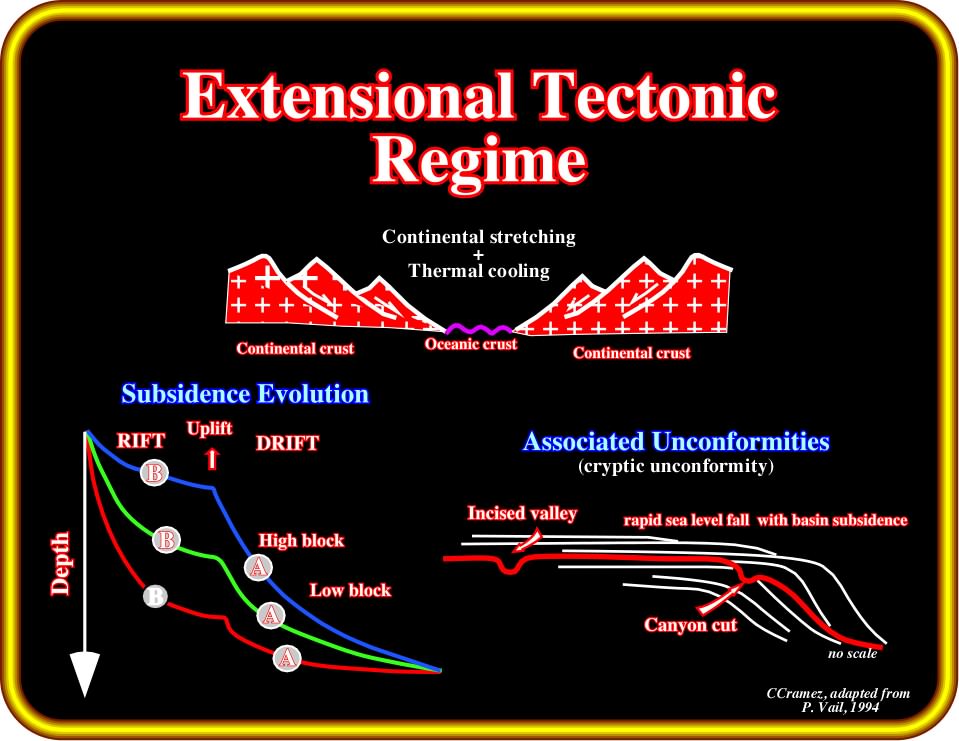
Plate 286- Subsidence profiles can be used to classify sedimentary basins. Bally and Snelson (1980) have used the realm of subsidence to classify sedimentary basins. In extensional tectonic regimes, rifting is associated with differential subsidence (rift-type basins), while drifting (thermal subsidence) characterizes divergent margins. In continental margins, unconformities, i.e., stratigraphic cycle boundaries, when not tectonically enhanced, are generally cryptic landward of the shelf break and in deep water. As illustrated in the seismic sketch (Associated Unconformities), the recognition of incised valleys and submarine canyons is, by far, the most efficient method to identify cryptic unconformities.
The tectonic subsidence curves of basins evolving during extension are characterized by a concave upward pattern (Plate 286). Generally, they show at least two concave upward subsidence patterns. One, during the crustal extension phase (rift-type basins) and another, during the drift thermal cooling phase (divergent margins). Additional concave upward patterns can be induced by other crustal extension episodes, as well as thermal perturbations.
On the tectonic subsidence curve of a basin evolving under a compressional tectonic (Plate 287) regime Vail wrote:
“The curve shows a typically flexure loading convex upward pattern. The period of maximum thrusting is commonly associated with the maximum subsidence because this is the time when thrust sheets are building up their maximum load on the border of the foredeep basin. Several convex upward subsidence patterns are commonly present within compressional basins indicating changes in the rate of the thrust movements. There may be a period of stability or uplift between convex upward subsidence curves. The uplift may be due to the heating of the depressed crust. Transpressional basins show similar flexure loaded convex upward patterns indicating loading of a land area adjacent to the basin. Some basins were formed during an extensional regime, which changed through time into a compressional regime. This change will be reflected in the basin subsidence curve, which will show a concave upward pattern in the early part, a convex upward pattern in the latter. The tectonic subsidence curve of a basin will commonly show extensional or compressional pattern. Changes in basin type will generally be apparent from the curve pattern. The tectonic subsidence curve associated with each type of sedimentary basins reflects the subsidence history of each basin, and in principle it represents the stratigraphic signature of first hierarchical level tectonic events. Each concave or convex upward pattern on the tectonic subsidence curve is generally associated with transgressive-regressive facies cycles. Transgressive-regressive facies cycles are stratigraphic signatures of changes in the rate of tectonic subsidence and are considered the signature of middle level tectonic events. Folding and faulting occur during particular periods of the tectonic subsidence curve depending on the structure type. In extensional settings faulting is most active during the crustal extension phase. In compressional settings faulting is most active in the maximum subsidence phase. A tectonic subsidence curve influenced lower level tectonic events may show a deviation from the regional subsidence pattern. For example, a tectonic subsidence curve made in a basin formed under a compressional regime will show a high corresponding to the development of a structure that is causing the flexural loading. This high will be superimposed on the regional curve that will show maximum subsidence at the corresponding time”
The identification of the unconformities associated with extensional and compressional tectonic regimes is quite different:
- In extensional regimes, the unconformities are generally cryptic except in the upper part of the continental slope, near the shelf break (Plate 286), were, often, canyon cuts enhance the relative sea level fall.
- In compressional regimes, the unconformities are tectonically enhanced, as illustrated in Plate 287. The geometrical relationships between the chronostratigraphic lines underlying and overlying the unconformity are more clear and sharp than in extensional regimes. Such enhanced reflection terminations allow an easy identification of the erosional surfaces (unconformities) and there lateral downdip correlation with the paraconformities.
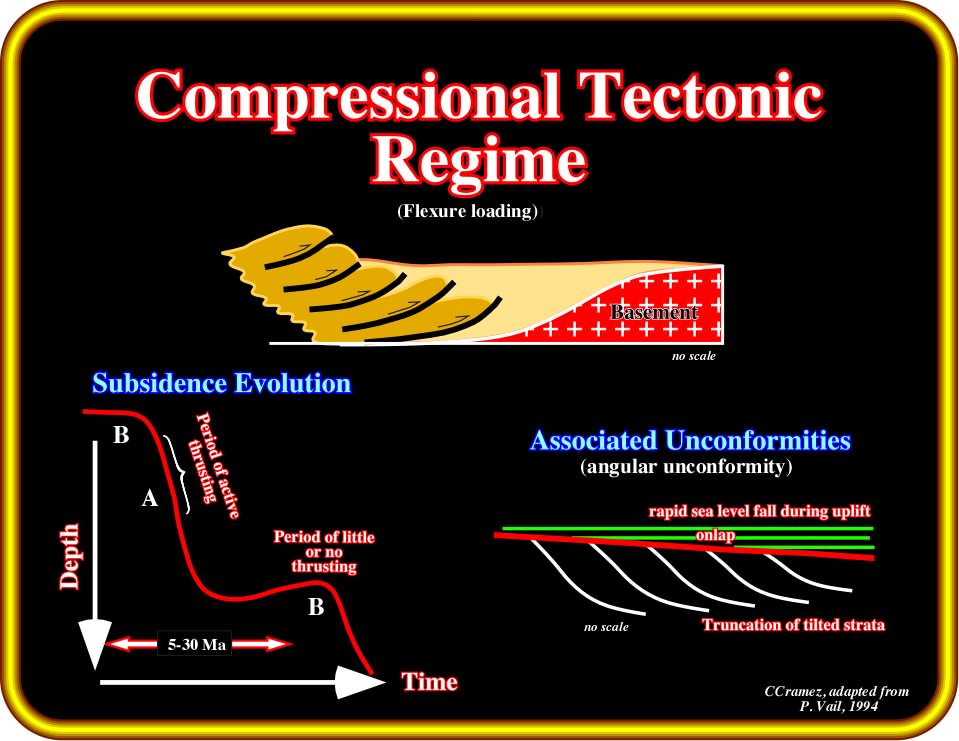
Plate 287- In compressional tectonic regimes, such as foredeep basins, for instance, subsidence profiles clearly indicate periods of strong shortening (active thrusting). The associated unconformities, bounding the stratigraphic cycles, are tectonically enhanced. When the Toplaping (erosional hiatus) is not evident, the unconformities can be cryptic. The onlapping of the transgressive sediments of the new stratigraphic cycle are often quite subtle, particularly when the encroachment of the coastal onlap is large (unconformity more or less horizontal).
The tentative interpretation of a seismic line illustrated in Plate 288 is characteristic of New Jersey offshore (Baltimore Canyon trough), which corresponds to a vertical superposition of Triassic-Jurassic rift-type basins and an Atlantic-type divergent margin, which age ranges from Cretaceous to Quaternary. The predominant tectonic regimes are extensional. The subsidence through time was mainly due to crustal extension (type-rift basin) and thermal cooling (divergent margin).
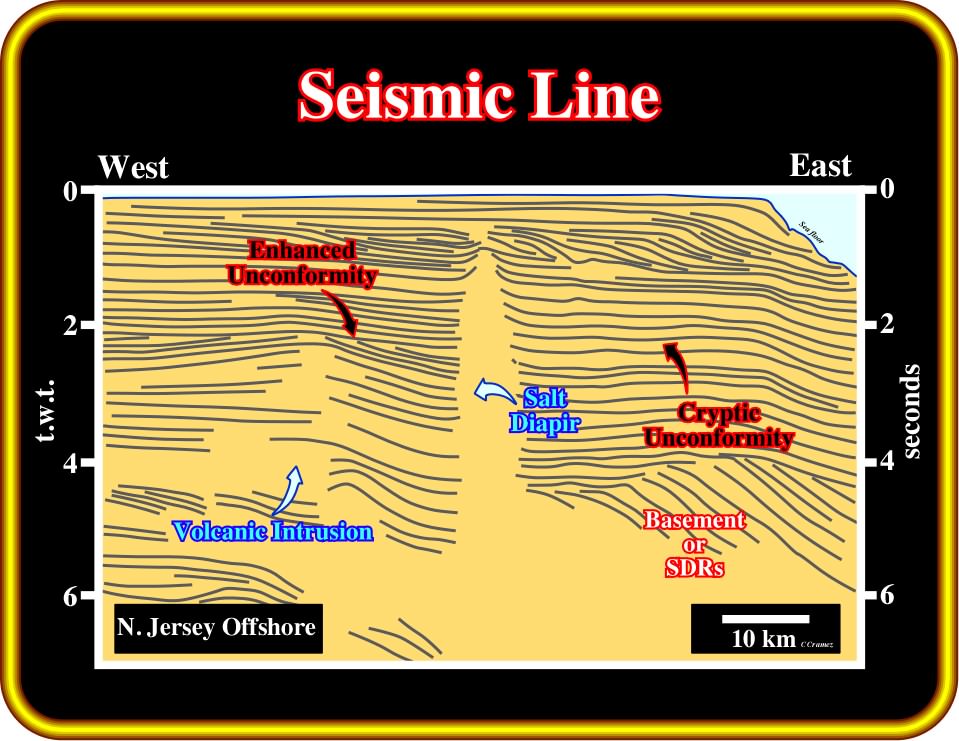
Plate 288 - On this tentative interpretation of seismic line, from North America divergent margin, a volcanic intrusion locally enhanced a cryptic unconformity. In the upper part of the tentative interpretation, the forestepping (progradational) interval, which corresponds to the Cenozoic, is often used to illustrate the importance of eustasy in stratigraphy, since, at that time, tectonic subsidence was quite insignificant. The basement and the post-breakup subaerial volcanism (SDRs) are quite high on the eastern part of the line. They form the eastern limit of a Triassic-Jurassic rift-type basin, which upper part is recognized in the central and western part of the line. The salt diapir seems to have used the fault plane, between the rift-type basin and the basement, to reach progressively the uppermost sediments.
The results of COST B-2 well, located not too far from the line illustrated on Plate 288, were used by Greenlee (1989) to calculate the eustatic fluctuations from stratigraphic data. The tectonic subsidence, total subsidence, paleobathymetry, long-term sea level, as well as the more likely subsidence mechanisms proposed by Greenlee in Plate 289, can be summarized as follows:
- Total subsidence curve indicates the depth to the bottom of the well at any particular time ;
- Decompacting the sediments and correcting for local isostatic compensation allow the calculation of the tectonic subsidence ;
- To obtain accurate results, the subsidence curve must also be corrected for paleobathymetry and the datum adjusted to the long-term sea-level curve ;
- Flexural loading may also influence the tectonic subsidence curve (variation in thickness of adjacent sedimentary units) ;
- To separate tectonic from eustatic effects, the subsidence curve obtained can be compared with theoretically calculated subsidence curves for various amounts of crustal stretching ;
- From the difference between the load-corrected subsidence curve and the interpreted thermo-tectonic subsidence curve, the 1st order eustatic cycle can be estimated as discussed by Hardenbol (1987).
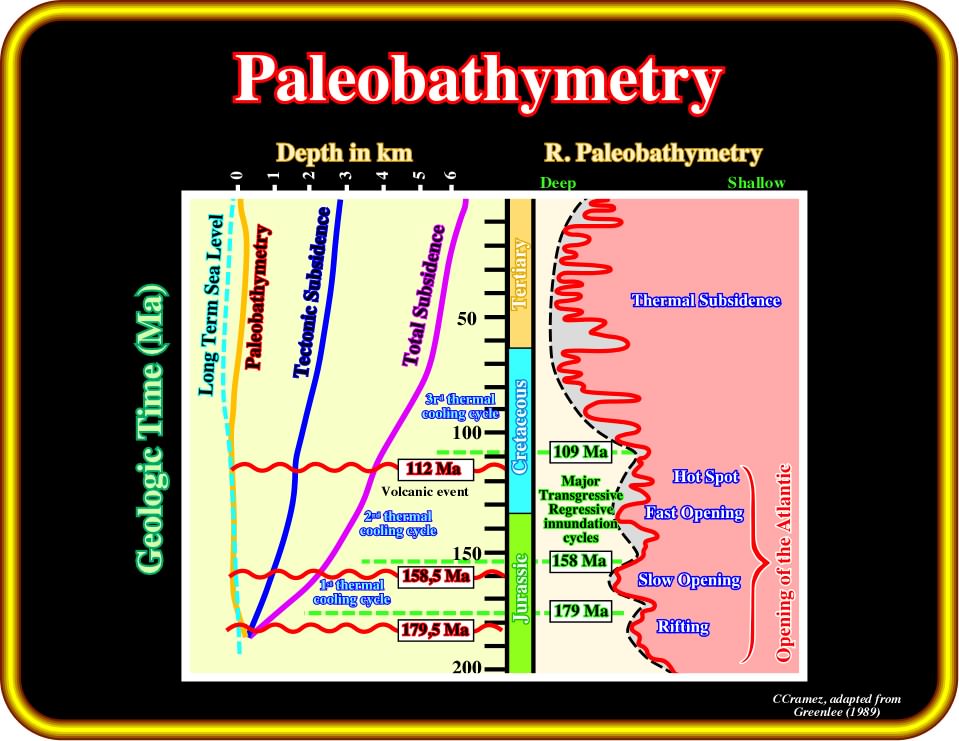
Plate 289- Using the results of COST B-2 and the seismic lines of the area, Greenlee calculated the eustatic fluctuations from stratigraphic data. The proposed tectonic (blue) and total (pink) subsidence, paleobathymetry (in brown), long-term sea level (dashed green) and the most likely subsidence mechanisms, have been corroborated by the results of the exploration wells drilled in North Atlantic offshore. A rifting phase (ending 179 Ma) , a slow opening (between 179 Ma and 158 Ma) followed by a fast opening and an hot spot (major transgressive / regressive inundation cycles) characterize the opening of Atlantic Ocean. Since 109 Ma a thermal subsidence predominates.
On the curves illustrated on Plate 289, Vail wrote:
“It shows a relatively high rate of subsidence during the basin type rift, and is followed by a normal thermal cooling subsidence after the opening of the Atlantic, 157 Ma. During the Aptian (116-109 Ma) thermal perturbation due to an igneous intrusion resulted in slight uplift. Normal thermal cooling was resumed after uplift. The thermo-tectonic subsidence curve shows tectonic events of middle hierarchical level, which start with increasing rates of subsidence. The first one extends from the late Triassic to late Jurassic (230?-157 Ma). The second one extends from late Jurassic to late Aptian (157-109 Ma) and the third from late Aptian to present (109-0 Ma). The same plate also relates the tectonic subsidence curve to variations in the paleobathymetry. Notice that there are four major transgressive-regressive facies cycles present. However, only three middle level tectonic events is visible one the thermo-tectonic subsidence curve. This is probably due to lack of stratigraphic resolution near the bottom of the well. Angular unconformities show that erosional truncation is present. They are indicated preceding the boundaries of the different stratigraphic intervals. Folding and faulting within the basin occurred during the four transgressive- regressive facies cycles. Normal faulting and other structures due to rifting were associated with the syntectonic phases of rifting, which preceded both the slow and rapid opening of the Atlantic. During the Aptian, magmatic activity induced doming”.
The amount of sediments is mainly related with tectonics, eustasy and climate :
- Compressional tectonic regimes induce uplift, which increases the amount of sediments available for deposition;
- Eustatic and relative sea level falls disrupt the equilibrium profile of the rivers increasing the amount of sediments. The rivers are forced to incise their beds to reach new equilibrium profiles.
- Climate is also an important factor not only in carbonate deposition but in sand-shale deposition as well.
Plate 290- A regression (seaward displacement of the shoreline) or a transgression (landward displacement of the shoreline) are mainly dependent of the terrigeneous influx. Generally, when the terrigeneous influx is high there is a displacement of the coastal deposits seaward (progradationa geometry). In particular cases, the terrigeneous influx can balance the relative sea level rise (creation of accommodation) and so the shoreline is not displaced (stationary shoreline). When the terrigenous influx is low the shoreline is displaced landward (retrogradational geometry).
In a basin, the terrigeneous influx changes in space and time. Such a change makes the global and regional correlations very difficult. This is illustrated in Plate 290, where three different geological situations are assumed (same RSL rise, but different terrigeneous influx) :
(i) In the first situation, the terrigeneous influx is low. The shoreline is displaced landward creating a backstepping geometry. The final result is a transgression.
(ii) In the second situation, the terrigeneous influx is high. The shoreline and the associated coastal deposits are displaced seaward. The internal configuration of bedding planes is progradational, which globally creates a forestepping geometry with a displacement the shoreline seaward. The final result is a regression.(iii) In the third situation, the terrigeneous influx balances the accommodation induced by the relative sea level rise. The shoreline and associated deposits are stationary.
As terrigeneous influx changes in time and space, particularly near the mouth of large rivers, correlation of transgression/regression cycles are often quite impossible, even at the basin scale.
Since the Exxon team held that tectonics is not responsible for generation of sequence boundary (unconformities type 1), several papers were published criticizing such a conjecture. Several geologists think that relative sea level changes can be also caused by continental tectonics that are regional to local in scope, and act over time periods of tens of millions to tens of thousands of years (possibly less).
“Tectonics of this type ... wrote Myall (1997)....
is driven primarily by plate tectonics processes. Extensional and contractional movements accompanying the relative motions of plates cause crustal thinning and thickening and changes in regional thermal regimes, and this leads to regional uplift and subsidence. These stresses and strains are generally primarily at plate margins but because of the rigidity of plates; they may be transmitted into plate interiors and affect entire continents. By their very nature these mechanisms of sea level change are regional, possibly even continental in extent, but cannot be global, because they are driven by processes occurring within or beneath a single plate or by the interaction between two plates. They affect the elevation of the plate itself, rather than the volume of the ocean basins or the water within them. This category of sea level change is therefore not eustatic. However, they can simulate eustatic effects through the full range of geological episodicities over wide areas, and it is now thought by many researches that tectonic mechanisms were responsible for many of the events used to define the global cycle charts of Haq et al. (1987, 1988). An important additional point is that because the earth is finite, regional plate-tectonic events, such as ridge reordering or adjustments in rotation vectors, may result in simultaneous kinematics changes elsewhere. It is possible therefore for tectonic episodes to be hemispheric or even global in scope. However, such episodes would take a different form (uplift, subsidence, extension, contraction, tilting, translation) within different plates and even within different regions of a given plate. It is possible therefore those simultaneous events of relative sea level change occurring over wide areas but of varying magnitude and in the same or opposite direction could be genetically related”Plate 291, taken from Watts (1982), clearly illustrates that the timing of major rifting events correspond grossly with the onset of the major rising relative sea level of the global cycle chart of Vail et al. In fact, it is easy to recognize that the rifting between North America and Africa, which took place at the end Triassic, appears interlinked with the initiation of Jurassic sea level rise.

Plate 291 - As depicted, the successive break-ups of the lithosphere seem to correlate with the major sea level falls of Exxon’s chart. Indeed, as said previously, the smaller the number of lithospheric plates, the higher the volume of the oceanic basins. In addition, the onset of sea floor spreading following the break-ups, particularly the emplacement of the oceanic ridges (oceanic mountains), decreases the volume of the oceanic basins and so, assuming a constant water volume since the earth’s birthday, the sea level rises.
In the same way, the rifting between South America and Africa is coeval with the Cretaceous initiation of the sea level rise. The relation between rifting and sea level rise is also valid when Newfoundland and Britain, Norwegian Sea and Baffin Bay, or Red Sea and Gulf of Aden broke apart.
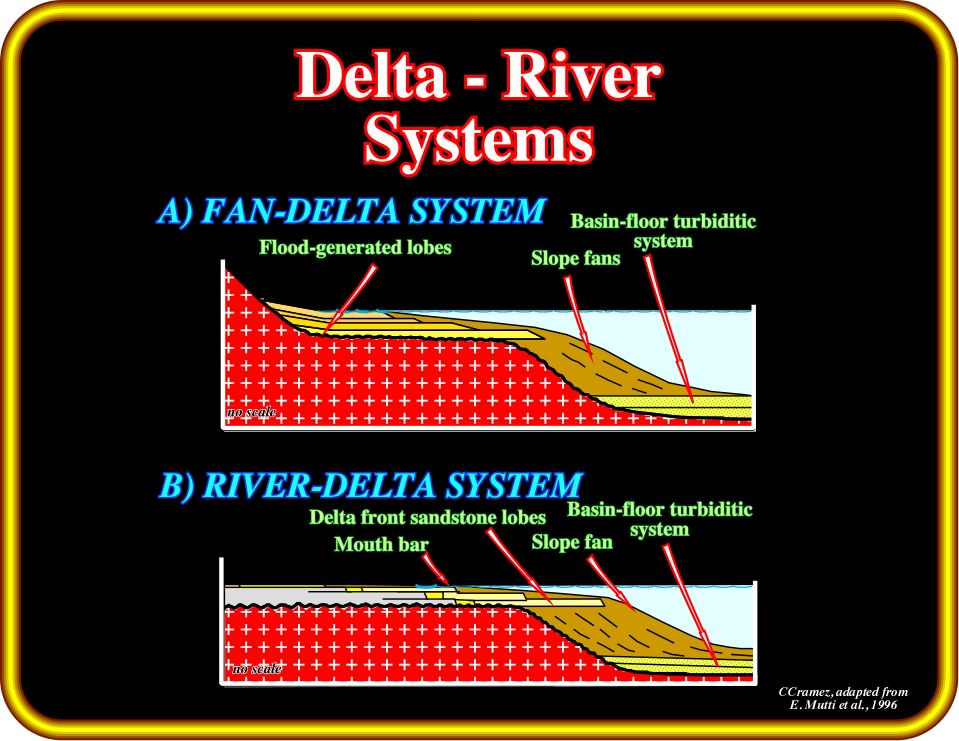
Plate 292 - In Mutti’s fan-delta and river-delta system model, the tectonic activity and catastrophic flooding are paramount. These depositional systems can be understood only in terms of tectonically controlled physiographic settings characterized by small and medium sized fluvial systems with high elevation drainage basins and high gradient transfer zones located close to marine basins.
In spite of the tectonic versus eustasy controversy, particularly in foreland basins, which will be discussed in detail in part III of these notes, I would like to include, what E. Mutti wrote on this subject, concerning tectonically active basins:
“Ancient fluvio-deltaic systems deposited in tectonically active basins are essentially built up intergradational fan-delta and river-delta systems dominated by catastrophic flooding. These systems and their component depositional elements cannot, therefore, be described and interpreted in terms of current sedimentological model based on “normal” fluvial and deltaic processes, facies and geomorphic settings derived from the study of modern environments. Despite this variability, all these sediments are characteristically composed of graded flood units in both alluvial and marine environments. The greatest preservation potential of individual flood units is found in the final marine depositional zones of each system considered. Ancient flood dominated fluvio-marine systems comprise huge accumulations of conglomerates, sandstone and mudstone facies whose origin and stratigraphic importance have been essentially overlooked in previous literature. These depositional systems can be understood only in terms of tectonically controlled physiographic settings characterized by small and medium sized fluvial systems with high elevation drainage basins and high gradient transfer zones located close to marine basins.”
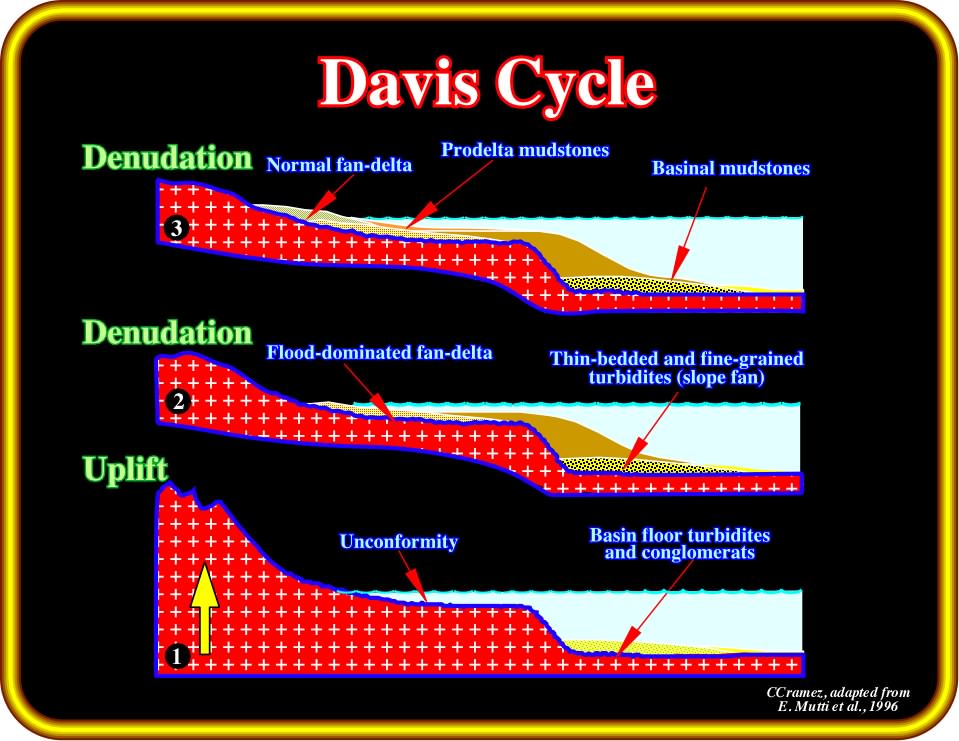
Plate 293 - These stacking patterns are apparently very similar to those which are thought to be characteristic of sequence-stratigraphic models (see later). Despite this apparent similarity, Mutti suggests that the overall vertical evolution of flood dominated systems is primary controlled by Davisian-type cycles, in which basal turbidite systems are overlain by a flood-dominated fluvio-deltaic system, which passes upward and landward into a normal fluvial or fluvio-deltaic system with time. Uplifting and denudation are responsible for flood-dominated and normal fan-deltas (Gilbert deltas). Sequential stratigraphic concepts are difficult to apply to flysch basins, where the tectonic control on the development of cycles of relative sea-level variations appears to be dominant. In particular, the huge volumes of sediment involved in the infill of flysch basins imply amounts of uplift of the source areas and subsidence of the receiving basins that clearly outstrip those of divergent continental margins controlled by eustasy and thermal subsidence. Cycles of tectonic uplift and denudation (Davisian-type cycles in the sense of Mutti et al., 1996) apparently play a major role here.
In settings of this type, sediment flux to the sea can dramatically increase when climatic conditions provide sufficient amounts of water to produce catastrophic floods (Plate 292 and 293):
- These floods generate mixtures of water and sediment that can enter seawater with significant velocity. Sediment concentration produces hyperpycnal flows and related shelf-sustained turbiditic currents.
- The resulting depositional settings are dominated by flood related facies. They can develop in shelfal or deeper marine regions.
- Thick and laterally extensive successions of shelfal sandstone lobes with flood generated hummocky cross-stratification (HCS) are the fundamental depositional element not only of fan-delta but river-delta systems as well.
- In terms of geometry, facies tracts, and high frequency cyclic stacking patterns, these lobes are essentially similar to deeper-water turbidite sandstone lobes.
- Shelfal sandstone lobes probably represent the only possible expression of fluvial-dominated delta-front sandstone facies. In the absence of flood generated hyperpycnal flows, river borne sands can only be redistributed in marine environments by waves and tides.
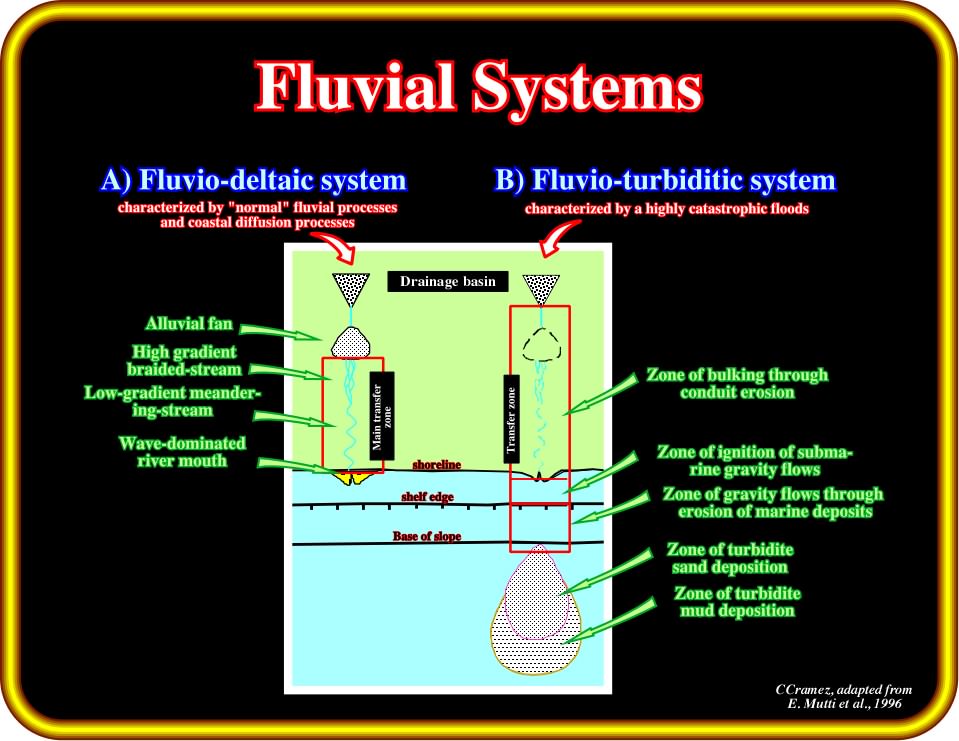
Send E-mail to carloscramez@gmail.com with questions or comments about these notes (Seismic-Sequential Stratigraphy).Plate 294 - In turbidite systems associated with highly catastrophic floods, it is important to take into account not only the drainage basin and the transfer zone, but also (i) the zone of ignition of submarine gravity flows, (ii) the zone of gravity flows through erosion of marine deposits (bypass zone) and (iii) the zones of deposition. As depicted above, the geological conditions are of highstand, what means that the turbiditic deposits cannot be associated to significative relative sea level fall, as suggested by P. Vail. In other words, in spite of the fact that the mechanism of deposition is more or less the same, turbiditic systems can be deposited in low (P. Vail's model) and highstand geological conditions (E. Mutti's model).
The overall stacking patterns and evolution of ancient flood-dominated fluvio-deltaic systems (Plate 294) with time is apparently controlled by the initial uplift of the drainage basin, the rate of denudation, the gradient of each system, and the volume and the sediment concentration of individual floods, which is a function of the amount of water and sediment made available to the system considered.
“A flood-dominated system of this type comes to an end when the sediment flux to the sea is progressively reduced to normal conditions. This occurs when relief and elevation drainage basins and related sediment availability, as well as the gradient of transfer zones have been substantially reduced through progressive denudation and sediment exportation to marine depositional zones. The occurrence of cyclic stacking patterns developed at different hierarchical orders is one of the most striking aspects of flood-dominated systems. The most complete record of this cyclicity is preserved in the final depositional zone of each system. These stacking patterns are apparently very similar to those which are thought to be characteristic of sequence-stratigraphic models. Despite this apparent similarity, we suggest that the overall vertical evolution of flood dominated systems is primary controlled by Davisian-type cycles (Plate 314). These cycles produced an overall forestepping backstepping succession recorded by a basal turbidite system (basin floor fan of sequence stratigraphy) overlain by a flood-dominated fluvio-deltaic system, which passes upward and landward into a normal fluvial or fluvio-deltaic system with time. Higher-frequency stacking patterns developed within each of the above stages are essentially produced by forestepping-backstepping episodes of sand deposition, which are essentially controlled by cyclic climatic variation. The relationships between Davisian-type and higher-frequency climatic cycles and eustasy-driven cycles of relative sea level variations remain to be explored through careful stratigraphic, sedimentological and structural studies carried out without preconceived ideas. It is likely, however, that the eustatic control on flood-dominated sedimentation patterns of high gradient, tectonically active settings cannot generally compare with the importance of tectonics and related cycles of uplift and denudation”